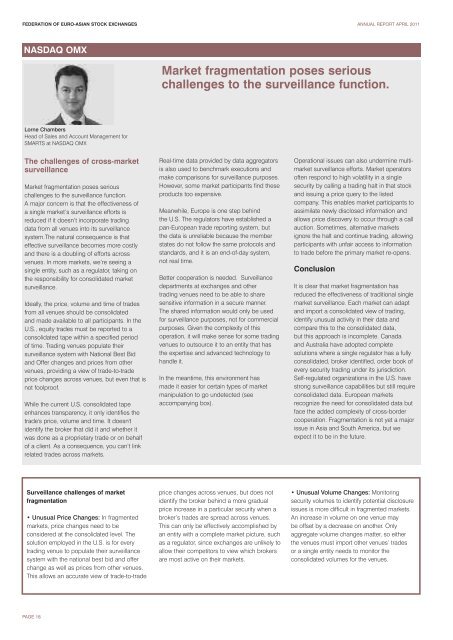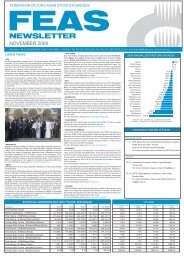Download - FEAS
Download - FEAS
Download - FEAS
You also want an ePaper? Increase the reach of your titles
YUMPU automatically turns print PDFs into web optimized ePapers that Google loves.
FEDERATION OF EURO-ASIAN STOCK EXCHANGES ANNUAL REPORT APRIL 2011<br />
NASDAQ OMX<br />
Market fragmentation poses serious<br />
challenges to the surveillance function.<br />
Lorne Chambers<br />
Head of Sales and Account Management for<br />
SMARTS at NASDAQ OMX<br />
The challenges of cross-market<br />
surveillance<br />
Market fragmentation poses serious<br />
challenges to the surveillance function.<br />
A major concern is that the effectiveness of<br />
a single market’s surveillance efforts is<br />
reduced if it doesn’t incorporate trading<br />
data from all venues into its surveillance<br />
system.The natural consequence is that<br />
effective surveillance becomes more costly<br />
and there is a doubling of efforts across<br />
venues. In more markets, we’re seeing a<br />
single entity, such as a regulator, taking on<br />
the responsibility for consolidated market<br />
surveillance.<br />
Ideally, the price, volume and time of trades<br />
from all venues should be consolidated<br />
and made available to all participants. In the<br />
U.S., equity trades must be reported to a<br />
consolidated tape within a specified period<br />
of time. Trading venues populate their<br />
surveillance system with National Best Bid<br />
and Offer changes and prices from other<br />
venues, providing a view of trade-to-trade<br />
price changes across venues, but even that is<br />
not foolproof.<br />
While the current U.S. consolidated tape<br />
enhances transparency, it only identifies the<br />
trade's price, volume and time. It doesn't<br />
identify the broker that did it and whether it<br />
was done as a proprietary trade or on behalf<br />
of a client. As a consequence, you can’t link<br />
related trades across markets.<br />
Real-time data provided by data aggregators<br />
is also used to benchmark executions and<br />
make comparisons for surveillance purposes.<br />
However, some market participants find these<br />
products too expensive.<br />
Meanwhile, Europe is one step behind<br />
the U.S. The regulators have established a<br />
pan-European trade reporting system, but<br />
the data is unreliable because the member<br />
states do not follow the same protocols and<br />
standards, and it is an end-of-day system,<br />
not real time.<br />
Better cooperation is needed. Surveillance<br />
departments at exchanges and other<br />
trading venues need to be able to share<br />
sensitive information in a secure manner.<br />
The shared information would only be used<br />
for surveillance purposes, not for commercial<br />
purposes. Given the complexity of this<br />
operation, it will make sense for some trading<br />
venues to outsource it to an entity that has<br />
the expertise and advanced technology to<br />
handle it.<br />
In the meantime, this environment has<br />
made it easier for certain types of market<br />
manipulation to go undetected (see<br />
accompanying box).<br />
Operational issues can also undermine multimarket<br />
surveillance efforts. Market operators<br />
often respond to high volatility in a single<br />
security by calling a trading halt in that stock<br />
and issuing a price query to the listed<br />
company. This enables market participants to<br />
assimilate newly disclosed information and<br />
allows price discovery to occur through a call<br />
auction. Sometimes, alternative markets<br />
ignore the halt and continue trading, allowing<br />
participants with unfair access to information<br />
to trade before the primary market re-opens.<br />
Conclusion<br />
It is clear that market fragmentation has<br />
reduced the effectiveness of traditional single<br />
market surveillance. Each market can adapt<br />
and import a consolidated view of trading,<br />
identify unusual activity in their data and<br />
compare this to the consolidated data,<br />
but this approach is incomplete. Canada<br />
and Australia have adopted complete<br />
solutions where a single regulator has a fully<br />
consolidated, broker identified, order book of<br />
every security trading under its jurisdiction.<br />
Self-regulated organizations in the U.S. have<br />
strong surveillance capabilities but still require<br />
consolidated data. European markets<br />
recognize the need for consolidated data but<br />
face the added complexity of cross-border<br />
cooperation. Fragmentation is not yet a major<br />
issue in Asia and South America, but we<br />
expect it to be in the future.<br />
Surveillance challenges of market<br />
fragmentation<br />
• Unusual Price Changes: In fragmented<br />
markets, price changes need to be<br />
considered at the consolidated level. The<br />
solution employed in the U.S. is for every<br />
trading venue to populate their surveillance<br />
system with the national best bid and offer<br />
change as well as prices from other venues.<br />
This allows an accurate view of trade-to-trade<br />
price changes across venues, but does not<br />
identify the broker behind a more gradual<br />
price increase in a particular security when a<br />
broker’s trades are spread across venues.<br />
This can only be effectively accomplished by<br />
an entity with a complete market picture, such<br />
as a regulator, since exchanges are unlikely to<br />
allow their competitors to view which brokers<br />
are most active on their markets.<br />
• Unusual Volume Changes: Monitoring<br />
security volumes to identify potential disclosure<br />
issues is more difficult in fragmented markets.<br />
An increase in volume on one venue may<br />
be offset by a decrease on another. Only<br />
aggregate volume changes matter, so either<br />
the venues must import other venues’ trades<br />
or a single entity needs to monitor the<br />
consolidated volumes for the venues.<br />
PAGE 18
















